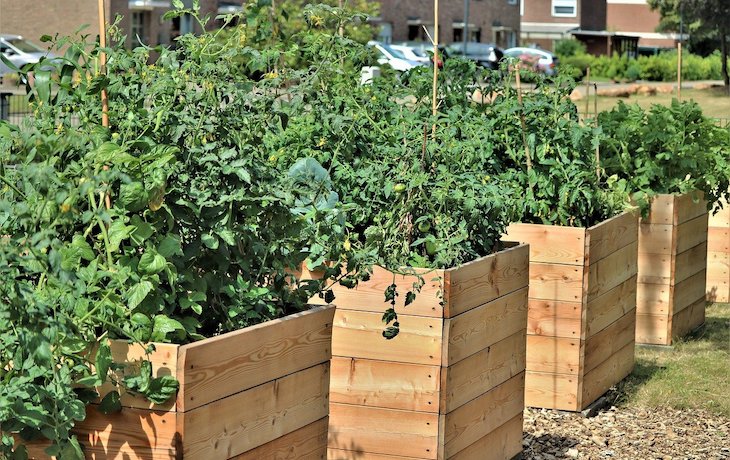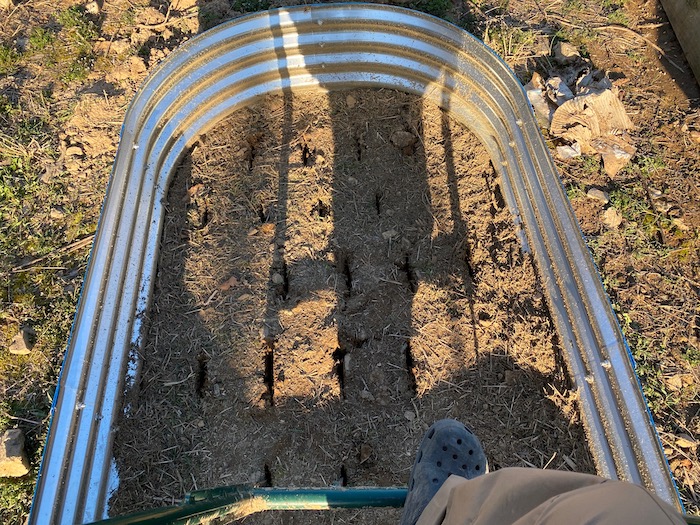Spring is here, which means it’s time for yet another gardening season. I’ve spent a lot of time over my past year with The Prepared considering the ideal form for a survival garden. Tilled rows? In-ground beds? Raised beds?
After a great deal of study and consideration, and with a great deal of input from The Prepared’s gardening community, I’ve come to believe the best solution for most preparedness-minded gardeners is raised beds.
Summary:
- A raised bed is simply that: the soil you plant in sits higher than the normal ground level around it. That could just be a mound of dirt.
- But most people mean a bed with some kind of frame/border around it, whether it’s still sitting on the ground or up on stilts.
- One of the biggest pros to raised beds is the ability to work around the bad soil on your land. Instead of trying to work within or improve that bad soil, you just bypass it with a bed where you control everything that goes into it.
- For example, if you use precious fertilizer / compost, it will stay contained exactly where you need it instead of being washed away, trampled on and spread around by animals, etc.
- Even if you start out with a rich compost or soil mix, you’ll need to add nutrients and minerals back between plantings.
- If your area is prone to heavy rains or flooding, raised beds drain better and typically won’t drown your plants.
- The frames around the bed help keep out unwanted visitors while also providing a great mounting point for extra gear like hoses or wire frames.
- Raised beds don’t require heavy machinery or fuel to break up the hard soil, which is a huge advantage in a long-term emergency.
- Bending over or working on your knees at ground level is physically tough even for the able-bodied. Raised beds are excellent for the disabled, elderly, or those who just don’t want the back pain.
- You do spend more money and time up front with most raised beds, but you gain it back over the long run and come out ahead. So raised beds are generally easier for people who don’t have time to garden all day.
What is a raised bed?
When most people refer to raised beds, they’re talking about a box of some sort, usually placed on the ground, that is filled with soil, often a bagged mix bought at a store. Typically the box has an open bottom so the contents are in contact with the ground, which gives plant roots more room to grow.
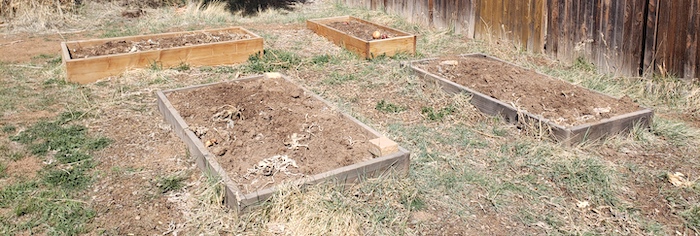
But a raised bed doesn’t necessarily have to have a frame. John Jeavons in How to Grow More Vegetables and Steve Solomon in Gardening When It Counts both describe in-ground “raised beds” that are created by loosening soil and adding compost, which creates an elevated planting surface. Charles Dowding creates no-till raised beds by dumping compost over a layer of cardboard, though he sometimes uses a frame to help shape the mound.
I’ve decided to opt for raised beds in a box, so for the rest of this article, when I refer to a raised bed, I mean a garden in a box of some sort.
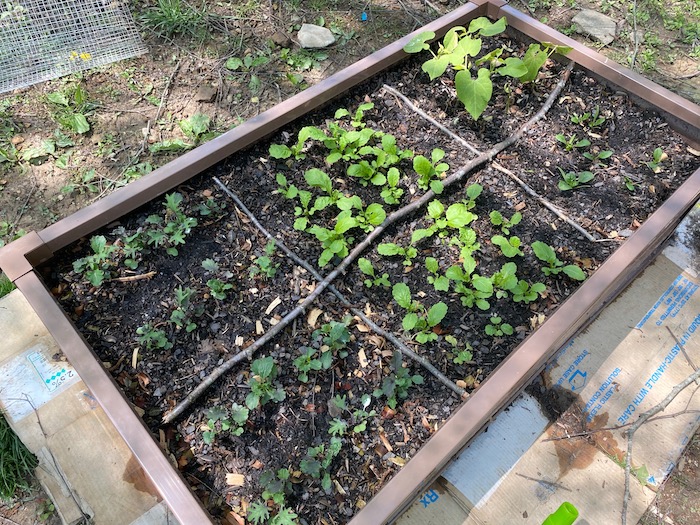
But even if you use a frame, that doesn’t necessarily mean you have to buy soil. In The Mini Farming Bible, Brett Markham describes raised beds that are “double dug” with a shovel and fork and amended with compost.
Raised beds help work around bad soil
While you can use your own native soil to fill a raised bed, the main reason I figure most people choose raised beds is so they can avoid it.
That’s at least part of my motivation. Here in Middle Tennessee, we have incredibly dense rocky clay. It’s exhausting to work by hand, and my patch seems especially difficult. My neighbor helped till my garden last year, and the hard soil broke a piece of his tractor.
I’ve spent the past few months experimenting with digging beds with various hand tools, like a broadfork and wheel hoe. It’s been slow, exhausting work. The ground is practically impenetrable when dry and forms rock-like clods if dug wet. Though to be honest, there are clods even when I work it dry.
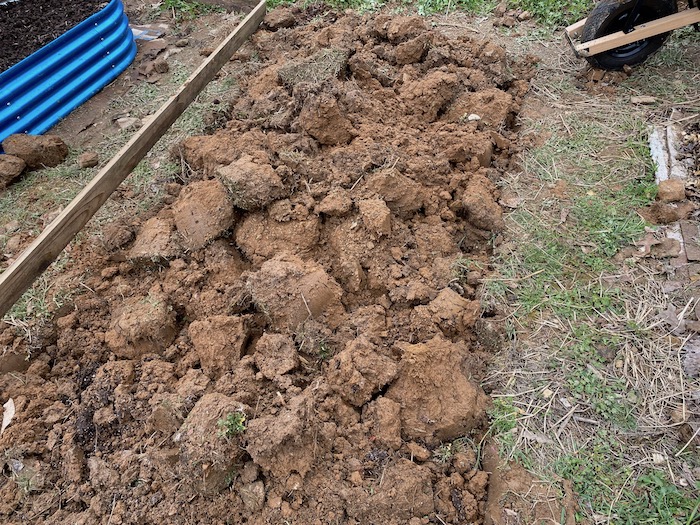
And yet another example of situational awareness: I finally realized everyone around here with a garden either works the ground with a tractor or uses raised beds. When in Rome, do as the Romans do, and raised beds are cheaper than a tractor.
If you have drainage problems such that water sits on the surface of your soil and drowns plants, raised beds do not have that problem.
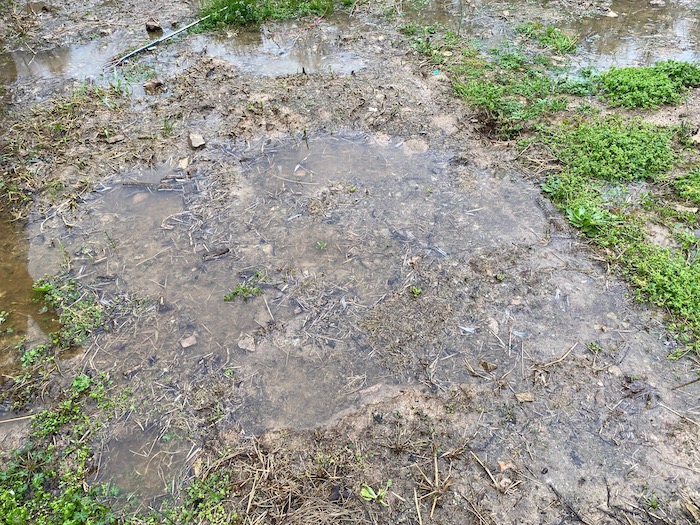
Raised beds can reduce your reliance on external inputs
There are three ways to make a garden bed:
- Till the soil with a tractor or tiller
- Dig the soil with hand tools
- Pile organic matter on the ground and plant into it
For the sake of preparedness, we want to reduce our reliance on external inputs. Tractors and tillers need a steady supply of fuel. If you’re depending on your garden to feed yourself, and you can’t get fuel, you have a big problem.
If the world’s gone to hell, you might have plenty of time to work your garden with hand tools all day every day like a medieval peasant. But in the here and now, when you need to be building your gardening skills, you probably don’t have time for that. We live busy lives and need to find methods that are productive and time efficient.
So-called no-till gardening has you drop organic matter on the ground instead of digging. Raised-bed gardeners who buy bagged mixes do this whether they realize it or not. Some practice various methods of in-place composting by filling garden beds with stuff like wood chips and leaves, but it takes time for that stuff to break down.
I don’t like using the bagged stuff because you never know what’s in it. Garden-destroying aminopyralid contamination is a big threat to no-till gardeners who have to import materials. I opted for compost from a local organic farmer who’s even more paranoid than I am about purity.
You might say I haven’t reduced my reliance on external inputs after all, but I have in the long term. Once the compost is in a bed, it’s there to stay since it’s as broken down as it ever will be. I’ll add various amendments every season to improve and replenish it, but the box frame will prevent or at least reduce run-off and keep my compost from blowing away in a strong wind.
Raised beds concentrate garden amendments
I spent three years building up my compost stores before starting a garden on this land. Last year, in between tilling passes with the tractor, I emptied the entire compost bin onto the field, along with large quantities of lime and various fertilizers. I had an outstanding garden, but overall, the improvements to the soil were like peeing in the ocean.
I decided that it would be much better to concentrate my compost and garden amendments into smaller, more focused areas. Three years of compost was gone in a flash without much to show for it, but if I had used that compost to fill raised beds it would still be there today.
Raised beds also make it easier to conduct experiments on various amendments, since there is a clear separation between beds. eg. I can grow spinach in two beds and try a fertilizer in only one bed to see how effective it is.
Any kind of frame helps protect your beds
One of the deciding factors in going with framed raised beds is that we live way too close to the road, and we never know who or what is going to wander onto our land. Recently, a couple of dogs wandered into my garden space while eyeing my chickens. If the soil hadn’t already been heavily compacted anyway, they would have trampled all over it for sure.
A daily threat is my children, who will happily trample over garden plants and loose soil without realizing it. Even a short frame sends a message to keep out.
Not to put too much of a blame on my children, because I’m a threat as well. I have some garlic growing in a hand-dug row and I’ve stepped on a couple of those plants myself (thankfully garlic is pretty tough).
Footsteps aren’t the only threat. There’s a borderless raised bed I dug that a contractor partially ran over while digging a trench for an electrical line. Again, a little wooden frame wouldn’t necessarily prevent that, but it would at least have let him know that he was running over something he shouldn’t.
And the frame helps hold that expensive soil or compost inside. Borderless raised beds flatten after a heavy rain and erode over time. Those borders help hold your precious soil in.
The frame also helps keep weeds from encroaching. Grass and other weeds will happily spread over an in-ground bed, but a frame discourages them somewhat. Weeds will still grow into raised beds — don’t let anyone tell you otherwise — but the border helps.
Raised beds are space and time efficient
The great thing about raised beds is that you don’t need much space to set one up. Kevin Espiritu, host of the Epic Gardening channel on YouTube, amassed over one million subscribers while gardening out of raised beds on a porch in San Diego. When he eventually bought land in the country, he just took the beds with him.
Brett Markham recommends raised beds for mini-farmers: “Raised beds and properly constituted soil make mini-farming practical. Modern people in the industrialized world have a lot less spare time and a lot less available land than their ancestors.”
Raised beds take time to construct, but they also save you time in the long run. Since your soil is well-contained and the borders discourage people and animals from stepping on and compacting the soil, there’s no need to keep digging your beds year after year. Fork in some fresh compost and add whatever amendments you need, and you’re ready to plant.
It’s much easier to work at table height than on the ground (especially for the physically challenged)
Ground-level garden beds are hard on your body. You either have to bend down or get on your knees to work in them. If you’re elderly or wheelchair-bound, for example, in-ground beds are probably impractical.
Meanwhile, you can build up raised beds as high as you please. My foot-tall steel beds are much easier on my back than my in-ground beds, and I can sit on the edge to work. Some gardeners build chest-high raised beds so they don’t have to bend at all. If you use a wheelchair, you can set raised beds at whatever height is comfortable for you to work in.
If you’re in a survival type of situation, you don’t want to strain your body unnecessarily. Throwing your back out sucks in the best of times.
Raised beds give you attachment points for accessories
The structure of a raised bed opens some possibilities that aren’t as easy to do with bare ground.
- Have a problem with burrowing critters like moles and gophers? Put hardware cloth down and set your bed frame on top of it to keep them out.
- Need to cover young plants due to an unexpected spring frost? If the plants haven’t reached the top of the bed you can throw plastic or a sheet over the bed and it’ll keep it suspended above the plants.
- You can attach rings to the side of a bed to attach hoops (for insulating plastic, shade cloth, or bug netting) or trellises for vining plants.
You can do these things with in-ground beds, but the raised bed frame makes it easier. For example, I had to cover tomato transplants in a row garden, and I had to first put stakes in the ground to support the cover and keep them off the tomatoes. Raised beds make it easier.
Do raised beds expand your growing season?
Some say soil in raised beds also tends to be warmer than the ground, so you can plant when it would otherwise be too cold. That’s supposedly because the planting surface is insulated from the heat-sucking ground and the sun hits your plants from multiple angles. Markham says raised beds raise soil temperatures by 8 to 13 degrees. And his raised beds are pretty shallow.
But some disagree with this assessment. Darian Lorat of Farmityourself.com says, “The short answer is no, though it is logical to think that raised beds maintain increased soil temperatures. If you are raising soil out of the ground’s surface, that soil might get warmer faster and retain heat longer.”
However, Lorat posits that raised beds might be warmer due to the soil composition. “A raised bed of soil that sits atop more soil will retain and release heat, just like the natural soil around it. On the other hand, the mix of your soil will affect temperature. Natural soil, peat, perlite, and potting soil all have different heat-retaining attributes affecting the speed with which your raised bed warms up or loses heat.”
Ultimately he says, “There are simply too many factors in play to determine that a raised bed alone will increase soil temperatures, but with clever engineering, it is possible to design a raised bed that will maintain higher-than-average soil temperatures.”
Downsides of raised beds
You have to build stuff: Many gardeners just don’t want to have to build or assemble bed frames. But if you’re close to a Home Depot or Lowe’s, you don’t have to. They both sell a product called Oldcastle Planter Wall blocks, which have slots for 2×6 lumber. Both stores will also cut lumber for you for no additional cost. So for each bed you can order four blocks, three eight-foot 2×6 boards, with one cut into two four-foot sections. Just slide it all together and you’re done. The blocks can stack up to three high for taller beds and have holes in the center to accommodate support rods.
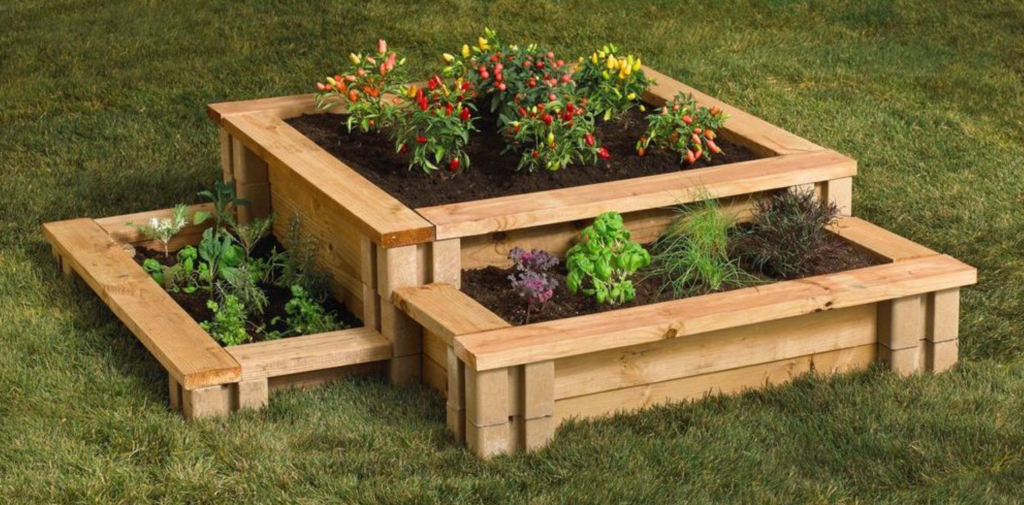
They’re expensive: Raised beds have higher start-up costs than in-ground beds. At the very least, you need to spend some money on a frame (with lumber at historically high prices), and even more so if you buy soil. If you invest in quality metal beds by Birdie, expect to pay around $150 a bed. Ouch! But there are cheaper metal beds for around $100.
For comparison, a 4×8 raised bed costs around $50 in wood or concrete.
But bed frames last years, even when made out of untreated lumber (how long depends on your environment). And consider the benefits of time savings and not losing your precious soil to erosion or weeds.
In the time it takes me to dig a single bed in the ground, which will still leave me with lumpy, difficult soil, I can drive to a store, buy a frame and soil, assemble the frame, and fill it. I’ll be less tired and have a better bed to start out. If I buy stuff for several beds at once, I can set up beds even faster than digging them. What’s your time and energy worth?
They’re limiting: Most raised beds are 4×8 or smaller, so you don’t have a lot of room to work. You can get around that with intensive planting techniques, but space-loving plants like corn and squash are tougher.
Raised beds force you to get creative. Trellises are practically a must for vining crops. Corn can be planted in raised beds, but you may have to choose smaller cultivars. If you have space, you might have a section of raised beds for various crops and then a separate area for field crops like corn.
I’ll only have 3-4 raised beds this season, so I’m going to dedicate the rest of my garden space to what David the Good calls “melon pits.” He digs a hole, fills it with kitchen scraps and compostable material, and then builds a mound with the soil to plant squash and melons into. The squash will cover the otherwise unused space, and I won’t have to dig or fertilizer a large area to produce a lot of food.
They’re thirsty: The good thing about raised beds is they have excellent drainage. The bad thing is they have excellent drainage. Water drains quickly through raised beds, so you need to water them often, especially if you’re using intensive planting techniques. That’s enough for some to completely write off raised beds for survival.
But why? Harvesting rainwater isn’t hard (unless it’s illegal in your area), so it doesn’t take much investment to keep your raised beds watered. Plus there are a number of drip irrigation systems designed to work well with raised beds that cut out the work.
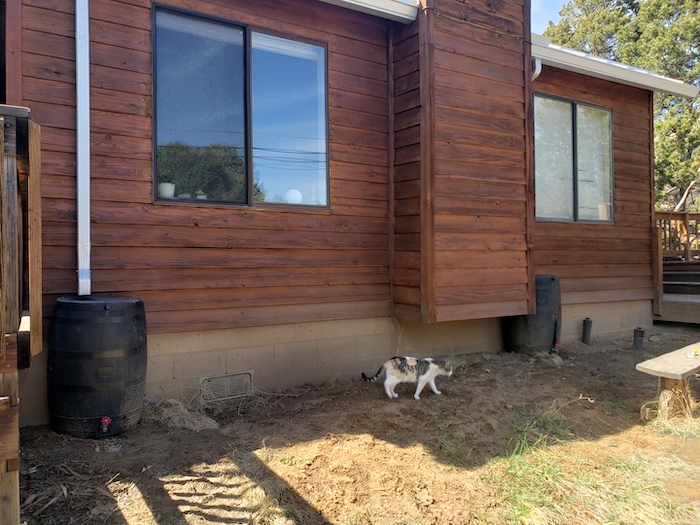
Weighing the pros and cons, I would much rather have a system that does a better job of maximizing my compost and fertilizer (expensive), even if it takes more water (cheap or free).
They don’t improve the soil: There’s an idea that raised bed gardeners are somehow “cheating” or are gardening in a way that’s completely disconnected from their environment. But it just isn’t true!
No one calls Charles Dowding a fraud when he lays cardboard down, dumps compost on it, and plants into it. So what’s the difference if you dump the compost in a box?
Tip: If your raised bed still opens up to the ground underneath, stab the ground with a fork (ideally a broadfork) before filling your raised bed. That aerates the ground, letting water and nutrients soak in while giving earthworms an easy path up. If you have heavy clay like I do, the ground under the raised bed will soften over time, so even if you have a somewhat shallow bed, roots will be able to penetrate the earth.
I then throw overlapping layers of cardboard on the ground to suppress weeds and encourage earthworms and put my frame over that.
Another thing I plan to do with my raised beds is surround them with woodchips. The woodchip mulch will suppress weeds because microbes will consume great deals of nitrogen while digesting the woodchips. And once the woodchips are broken down they’ll leave behind a rich layer of soil. It’s really no different than the Back to Eden method, except I’ll have fertile beds to grow in while I wait for the wood chips to break down.
This brings me to my final point…
They don’t last: Wood rots, concrete blocks eventually collapse, and metal beds rust out. Your beds won’t last forever, though it’s hard to put a number on it — I’ve heard anything from six months to 20 years.
Mark Valencia, host of the Self Sufficient Me YouTube channel, has metal beds that have been in use since 2006. Raised bed lifespan depends on your temperatures, moisture levels, the presence of pests like termites, salt in the air, and so on, so it’s hard to say just exactly how long they’ll last.
But if you mulch heavily around your beds to enrich your soil and concentrate a lot of compost and good amendments in that bed area, it might not matter if your frame falls apart? You’ll have a good, rich patch of soil full of organic matter. That’s not a loss by any stretch.
